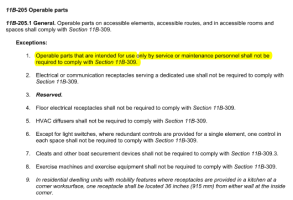user_pc_9876
REGISTERED
Trying to install some electronic locks on doors in a building in California and hoping for some assistance navigating a discrepancy between the CBC 11B-404.2.7 and the IBC 1010.2.3:
11B-404.2.7 of the CBC states that "Handles, pulls, latches, locks, and other operable parts on the doors and gates shall comply with Section 11B-309.4. Operable parts of such hardware shall be 34 inches (864 mm) minimum and 44 inches (1118 mm) maximum above the finish floor or ground." (emphasis added).
Meanwhile, the IBC 1010.2.3 seems to specify a maximum height of 48 inches for the hardware.

The locks we are looking to install have an operable internal push button at around the 45-46 inch mark.
My sense in asking around was that, while CBC has a more stringent rule with respect to the maximum allowable height, AHJs have not taken issue with locks are as long as their operable parts are below 48 inches. Has anyone else dealt with this issue specifically? Also, I am not seeing the exception in the CBC for "locks used only for security purposes and not used for normal operation" -- does anyone know the history of this exception and if some version of it exists in the CBC?
11B-404.2.7 of the CBC states that "Handles, pulls, latches, locks, and other operable parts on the doors and gates shall comply with Section 11B-309.4. Operable parts of such hardware shall be 34 inches (864 mm) minimum and 44 inches (1118 mm) maximum above the finish floor or ground." (emphasis added).
Meanwhile, the IBC 1010.2.3 seems to specify a maximum height of 48 inches for the hardware.

The locks we are looking to install have an operable internal push button at around the 45-46 inch mark.
My sense in asking around was that, while CBC has a more stringent rule with respect to the maximum allowable height, AHJs have not taken issue with locks are as long as their operable parts are below 48 inches. Has anyone else dealt with this issue specifically? Also, I am not seeing the exception in the CBC for "locks used only for security purposes and not used for normal operation" -- does anyone know the history of this exception and if some version of it exists in the CBC?



